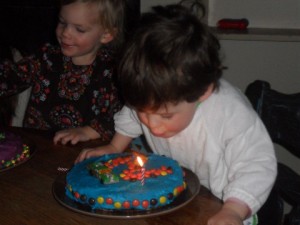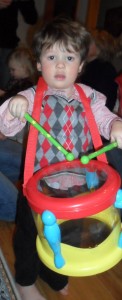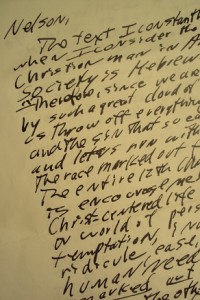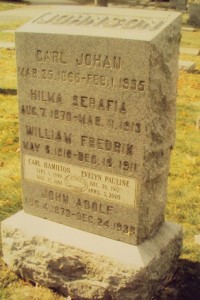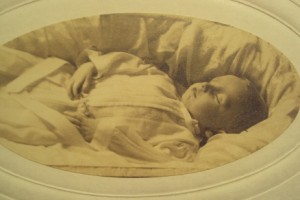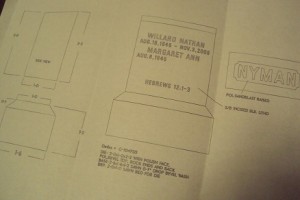As a young mom I always fantasized about having twins. I would have given them matching names (Pam and Pat, Jennie and Jonnie) and dressed them in matching outfits every day. God didn’t put twins among my children but sent them one generation later, to Hans and Katy.
Today we celebrated the birthday of an unusual set of family twins, though, and it wasn’t Thomas and Evelyn. When Katy was pregnant with Nicholas, their first child, my niece Johanna was also pregnant. Interestingly, Hans and his cousin Jo have been pals since babyhood, both being born in 1982 and spending much childhood time together.
Their weddings took place several months apart, and when we learned they’d be having babies close together, too, it was like the frosting on the cake. Jo’s baby was due in December of 2008, Hans’ in January of 2009. But Jo’s Ruby came many days late, and Hans’ wife Katy delivered Nicholas many days early. Our cross-Atlantic twins arrived on the same day, nearly during the same hour.
I’ve enjoyed watching Ruby grow and change as a visual for what Nicholas was also doing, far away across five time zones. When I held Ruby, I thought about holding Nicholas, and it helped my missing his babyhood.
The cousin-twins turned two today, getting into the birthday excitement with vigor, as most two’s do. Although Nicholas won’t be able to celebrate with Ruby when they turn three, today they entertained us at their double-birthday bash, cooperating with every part of the day and smiling on cue in front of a bank of cameras. We marveled at their stamina and the absence of meltdowns, a happy day all around.
After their mellow behavior today, no one would guess they can both pull out all the stops with some classic tantrums. Just a few days ago Nicholas went to the wall over an insignificant issue, testing his parents to the limit. They didn’t cave (kudos) and kept their voices calm as they gently but firmly resisted his childish ploys. As he was carried upstairs, the supersonic noise level diminished, and Nelson and I looked at each other.
“What was that?” he said.
“Original sin.”
Just because these little ones are generally agreeable, it doesn’t mean the “evil in the human heart” isn’t lurking just beneath the surface. It’s present in every one of us and was the very reason Christ came to die. Watching a two year old fit of temper dispels the myth that human beings are basically good.
But it’s an oxymoron that just as they’re melting down, screaming and kicking, they’re irresistibly adorable with their pink cheeks and pudgy limbs. I think God made them that way so we’d give them the benefit of the doubt when things got questionable.
But today our cousin-twins were well-behaved. And I know they’ll look darling in the twin red hoodies that were among their gifts.
“The heart is deceitful above all things and beyond cure. Who can understand it?” (Jeremiah 17:9)

